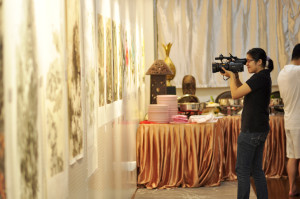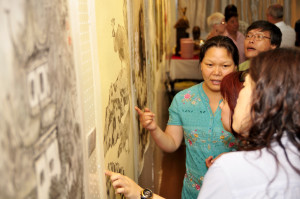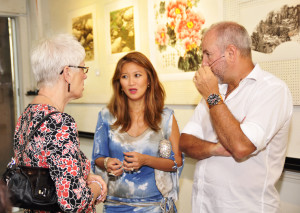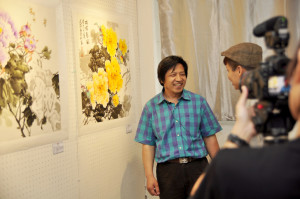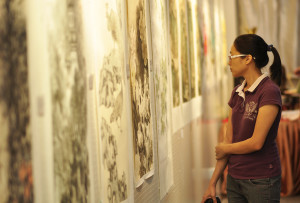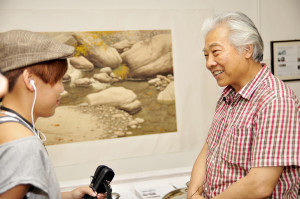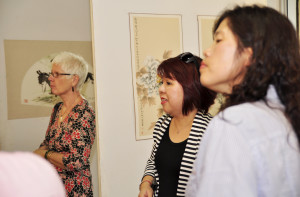马来西亚槟城乔治城艺术节中国周
墨韵 - 河洛丹青艺术展
2013年6月15日至6月22日ALYSSA GALERI
346,10000乔治敦,马来西亚槟城,槟城路
开放时间:上午10:30至下午六时,www.alyssagaleri.com
河洛文化
河洛文化发源于河洛地区,是指黄河与洛河交汇处以洛阳为中心的这样一个广大地区。黄河与洛河的考古发现表明,早在5000年前人类就在这里繁衍生息。这个区域也被称为“九州腹地”或“十省通衢”,意为“中之国”,“中国”之名由此而来。河洛文化并不是一般的地域文化,它不但是中国史前文化的源头,更是中国进入文明社会以后文化发展的轴心,对中华民族文化的形成和发展起着巨大的推动和导向作用。
河南洛阳坐落在黄河与洛河之间,是中国文明最重要的发祥地之一。以洛阳为核心的河洛地区曾长期处于全国的政治、经济和文化的中心,因而从古至今,它都深刻地影响着中国的哲学,宗教,科技,教育,文化,经济等方方面面。河洛文化的代表“河图洛书”,是最早的中国文化经典,被誉为“人类社会的根源和人类文化的始祖”。
洛阳是中国历史上第一个王朝建都之地,先后有夏(公元前2,100-1,600),商(17世纪 - 公元前11世纪),周(11世纪 - 公元前256年)等13个朝代在此建都,为河洛文明营建了一条清晰的脉络。历史上,洛阳几经兴废,在唐朝时期达到鼎盛,成为世界瞩目的国际大都市。
万山之祖的中岳嵩山,位于郑州和洛阳之间的平原上,由太室山和少室山组成。太室山前的中岳庙初建于秦朝(公元前221 -207),北魏时期(386 - 543)更名为中岳庙,为道教寺庙。院内设有多门,通往嵩阳书院。在寺庙中,有300多棵古老的柏树,和100多个铁铸的雕像和石碑。在少室山脚下的少林寺始建于北魏,以少林功夫享誉全球。位于少林寺西侧的塔林由230多个砖塔组成,陆续建于唐,宋,元,明,清等朝代,是中国同类塔林中规模最大的一个。
“庙会”起源于佛教和道教的宗教活动。它开始于某些传统节日期间,在寺庙附近的厂商群体向前来朝拜的信徒们出售商品。久而久之,这种现象逐渐演变成为一种约定俗成的群体活动。庙会是一种集宗教祭祀,文化娱乐和商品交易于一体的群众集会。现在的河洛庙会仍然延续着古老的传统,舞台演出,电子游戏,传统手工艺品展演,商品交易等无所不有,是洛阳当地人民极为重要的一个娱乐商务活动。
China Week George Town Festival, Penang, Malaysia
INK RHYTHM HELUO STYLE ART EXHIBITION
15th JUNE – 22nd JULY 2013 at ALYSSA GALERI
346, Penang Road, 10000 Georgetown, Penang, Malaysia
Opening Times: 10.30 am to 6.00 pm, www.alyssagaleri.com
Heluo Culture
Heluo culture originates in the Heluo area and refers to the Yellow and Luohe river connection with Luoyang at the centre. The archaeological discoveries of the Yellow and Luohe river indicated that as early as 5,000 years ago, human beings lived here. This area is called “the Kitakyushu centre” or the “ten provinces thoroughfare” and the name was derived from the meaning of “country” and “China”. The Heluo culture is not the general realm culture and in addition to being the source of Chinese prehistoric culture, it was the axis centre when China entered the civilised society forming the Chinese culture. Represented by “Hetu & Luoshu”, the earliest classics of Chinese Culture, the Heluo Culture is honoured as “the Ancestor of Human Root and Human Culture”
A total of 20 dynasties, from the Xia (2,100-1,600 BC), Shang (17th century – 11th century BC), Zhou (11th century – 256 BC), to the Jin (1115-1234), had their capital in Luoyang a major centre for the Heluo Culture. Historically, Luoyang experienced prosperity and growth, making it one of the most affluent cities of the Tang Dynasty.The magnificient Songshan Mountain towers on the plain between Zhengzhou and Luoyang, consisting of the peaks of Taishi and Shaoshi. Zhongzue (the Central Sacred Mountain) Temple at the front of Taishi was first built in the Qin Dynasty (221 -207 BC) and was renamed in the Northern Wei period (386 – 543). A Taoist temple, it has 11 gates leading to the Imperial Library. In the temple, there are 300 ancient cypresses, and more than 100 metal-cast statues and stone tablets. Shaolin temple at the foot of Shaoshi was built in the Northern Wei period, and has long been renown worldwide for kung fu, or the Chinese martial arts. There are 230 brick pagodas, the largest of its kind in China, erected during the Tang, Song, An, Yuan, Ming and Qing dynasties.
The “temple fair” (Miao Hui) originated along with the development of Buddhist and Taoist activities. It began with groups of vendors who did business near temples and pilgrims who came to pay tribute to the gods during traditional festivals. The practice grew, gradually turning into a regular event. Temple fairs are a kind of mass gatherings that integrate religious worship, entertainment and commerce. Now temple fairs are an important and joyful destination featuring performances, demonstrations, games, selling of traditional arts and crafts, for Luoyang local people.

